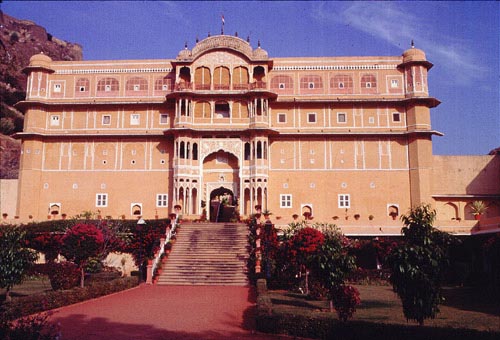Samode Palace

Information on Samode Palace (Jaipur, Rajasthan) - History & Architecture
Samode Palace is a custom monument of Jaipur established by the honourable feudatory. It has rich history and is popular for its attractive grandeur and prominent construction. Samode Palace retains its traditional attraction and folk sculptures which entices various tourists around the world. The palace is situated with a distance of 40 kilometre north from Jaipur. Presently, it has become a part of Heritage Group hotels. Several Bollywood movies have been developed with the background of Samode Palace. Furthermore, one Hollywood movie namely 'The Far Pavilions' was also videoed in Samode Palace in the year 1984.
Samode Palace Architecture
Samode Palace was designed with the blend of Rajput and Muslim architecture. The palace is built with brickwork at the base of Aravalli mounts, the prime highland of north-western India. The interior of Samode Palace is structured by Rajasthan architecture style comprising marble grounds, complicatedly decorated pillars, mosaic walls, deluxe carpets and ancient paintings. At the gateway of the palace, there lies exclusive piece of huge treasure, made of gloomy wood with marble background and shiny glass. The palace is established on three levels with a courtyard on every surface. At the top of the palace, there is an ancient fort, from where a panoramic scenery of the valley can be observed. Samode Palace was believed to be the former house of the king and it is also said that there was a secretive passageway in the palace which was used in the time of crisis.
Samode Palace History
Samode has a peaceable history with no battles or bloodsheds. Samode is a big city, which belonged to the landowners of the state of Amber. It was founded by Jai Singh and later it was bestowed to Gopal Singhji, which was one of the children of King Rajveer Singhji, the 17th prince of Kachawaha. The importance of this city had increased with appearance of numerous rulers of Kachawaha family. Afterwards, the accountability of Samode city was delegated to the British rulers.
Samode Palace was originally developed in 16th century as a Rajput castle. However, in 19th century, it was converted from castle to beautifully designed palace by Rawal Berisal. He was the guarantor of the king of Jaipur and was engaged in an agreement with the British East India Company in the year 1818. As a result, he was provided with the position of protectorate of Jaipur. Rawal Sheo Singh, the successor of Rawal Berisal additionally improved the structure of the palace by adding various structures such as 'Darbar Hall', 'Sultan Mahal' and 'Sheesh Mahal' (which is also termed as the 'hall of mirrors'). In the year 1987, Samode Palace was transformed into the legacy of 'Samode Palace Hotel'.
Samode Palace Tourism Importance
Samode Palace is a vivid specimen of imperial Rajput architectural design as well as Mughal ornamentation. Established in 16th century, this palace has significant importance from the viewpoint of tourism. It delivers graceful environment for travellers to enjoy vacation. It has fortress atmosphere and encompasses other important constructions such as 'Durbar Hall', 'Sultan Mahal' and 'Sheesh Mahal' which can be enjoyed by the travellers. Furthermore, there is also a little temple, situated within 3 kilometre of the palace. In sum, Samode Palace is an exciting example of royal era of India and is a must visit destination while exploring Samode city. No wonder, the Palace is surely going to treat you with its exceptional architectural phenomenon and beauty that is simply awe-inspiring. It is worth to pay visit while in Jaipur the Pink city of India to witness the marvel Samode Palace, which stands with the same pride and joy even after years of its construction.
- Andaman Nicobar Monuments
- Andhra Pradesh Monuments
- Assam Monuments
- Bihar Monuments
- Chhattisgarh Monuments
- New Delhi Monuments
- Goa Monuments
- Gujarat Monuments
- Haryana Monuments
- Himachal Pradesh Monuments
- Jammu and Kashmir Monuments
- Karnataka Monuments
- Kerala Monuments
- Madhya Pradesh Monuments
- Maharashtra Monuments
- Odisha Monuments
- Punjab Monuments
- Rajasthan Monuments
- Tamil Nadu Monuments
- Telangana Monuments
- Uttar Pradesh Monuments
- West Bengal Monuments